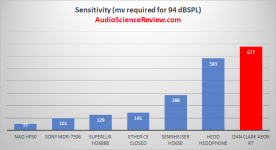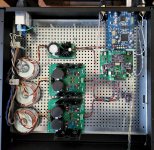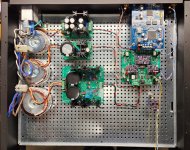On the feasability of driving planar magnetic headphones, I've been reading about the LME49600. It is designed to average 0.5 watt at 2 volts, so balanced that's a whole watt per channel. The only problem I see is driving them hard, in which case they'll heat up to possibly reach their thermal shutdown threshold. The data sheet goes into depth on heat dissipation by the mounting circuit board itself.
So now my qestion is: what is the weight of (heat-dissipating) copper on the Mercury - probably one ounce, correct?
I'll be ordering some stick-on heatsinks for the buffer tops and will also consider adding to their local power bypass reserve.
So now my qestion is: what is the weight of (heat-dissipating) copper on the Mercury - probably one ounce, correct?
I'll be ordering some stick-on heatsinks for the buffer tops and will also consider adding to their local power bypass reserve.
Question: Has anybody here tried driving planar magnetic headphones using Mercury? For example, the Dan Clark Aeons are only 13 ohms. Any direct experience?
Answering my own question - wow! Mercury is driving the Aeons single-ended with apparent ease. I will be checking part temperatures after some continuous use, but maybe no worries since the LME49600 has built-in thermal protection.
Planar magnetic headphones require significant time to 'break-in', so only after > ~150 hours can you fairly evaluate them. Now I can give a couple observations:
1. Mercury temperature - still ok after running 13 ohm drivers continuously for days. IR gun reports 113°F for the circuit board near the SE LME49600 (photo) and thats with no additional thermal management. Sometime when I'm inside this box I'll stick RPi heatsinks to the buffers, but no hurry.
2. Sound Quality - I've been building and tweaking stuff from Twisted Pear for a long time. THIS is the best sound yet. I'm not a headphone collector; my only other decent cans are old HD600s. But these planar magnetics are on a higher orbit. And even though I run very high resolution speakers from Buffalo 3 Pro DACs, I didn't know before this that the B3s had this level of transparency in them. Thus, I'm now converting other builds with different (very good) I/V stages to Mercurys.

1. Mercury temperature - still ok after running 13 ohm drivers continuously for days. IR gun reports 113°F for the circuit board near the SE LME49600 (photo) and thats with no additional thermal management. Sometime when I'm inside this box I'll stick RPi heatsinks to the buffers, but no hurry.
2. Sound Quality - I've been building and tweaking stuff from Twisted Pear for a long time. THIS is the best sound yet. I'm not a headphone collector; my only other decent cans are old HD600s. But these planar magnetics are on a higher orbit. And even though I run very high resolution speakers from Buffalo 3 Pro DACs, I didn't know before this that the B3s had this level of transparency in them. Thus, I'm now converting other builds with different (very good) I/V stages to Mercurys.
Last edited:
Does powering Mercury with two completely individual PSUs provide measurable and audible performance improvements compared to one PSU?
I never try before mercury because i dont have power supply . i have plan to use lifepo4 power from iam and i dont have change to finish .
I use one power supply. In theory you could get a benefit from using two, but I don't personally find it practical.
The Mercury has a high PSRR, so going with batteries is probably unnecessary, but I certainly wouldn;t try to talk you out of it.
The Mercury has a high PSRR, so going with batteries is probably unnecessary, but I certainly wouldn;t try to talk you out of it.
I "compromised" and used a single transformer with two secondaries. With two sets of 4 diodes, but then I created 4 separately filtered and regulated rails. While this approach is not fully dual mono, it provided exceptional sonics. I used an oversized transformer, (100 VA!) so there is certainly no impedance problems with the supply at that point, and each of the 4 separate rails has a large, 4 pole, Mundorf capacitor for individual filtering, followed by a small film cap, and then a Belleson, ultra low noise/impedance discrete regulator. I very much doubt there would be any difference going to a full dual mono setup with two transformers and four completely independent (including bridge rectification).Does powering Mercury with two completely individual PSUs provide measurable and audible performance improvements compared to one PSU?
I also used the Barrows approach of splitting dual secondaries. Although I don’t use as many regulation layers, the results are very satisfactory indeed. I do the same for the 5v side - one Centaur for everything ‘clean’ and a separate Centaur for ‘dirty’ components upstream of all isolator boundaries. The additional local regulators - like Tridents - seem to keep a lid on cross talk.
Yeah, I know that it sounds good while using good power supply. My previous DAC (BIII with ES9038Pro) had 4x IVY powered from single AMB gamma 22 and I couldn't hear any difference between utilizing 4x IVY vs 1x IVY. But since I'm building new DAC with Mercury and Russ implemented dual power supply capabilities on all TPA I/V stages, I'm just curious - should I use separate power sources for Mercury or is it just a snake oil.
Maybe the deciding factor should be the other components that will be paired with the Mercury. If your analog components are extremely resolving then it might make a noticeable difference. Less than the greatest equipment may not present any noticeable improvement.Yeah, I know that it sounds good while using good power supply. My previous DAC (BIII with ES9038Pro) had 4x IVY powered from single AMB gamma 22 and I couldn't hear any difference between utilizing 4x IVY vs 1x IVY. But since I'm building new DAC with Mercury and Russ implemented dual power supply capabilities on all TPA I/V stages, I'm just curious - should I use separate power sources for Mercury or is it just a snake oil.
FWIW, I had two Placid HD BP v2.1 powering my Mercury with 9038Pro. I removed one and honestly, I cannot tell a difference. Sonore Audiobyte USB to I2S used as it will run in scynch with BIII where I could never get the Amanero/Hermes/Cronus stack to run in synch.
My system is ARC Ref 3 pre, Krell KSA-250, Salk SS8 speakers, Signature Sonore server running Roon Rock with external powered SOtM USB card, so I believe I can hear differences if they are there. I have Roon upsample everything to Native DSD128, the limit Roon allows with the Sonore interface. IIRC the single HDBP is now at 290mA total output, shunting 100mA for headroom. It gets a little warmer but with the large sinks, nothing to worry about.
The Centaur was powering both the DAC and USB interface. I had an old LCDPS that I added to get out of the spare parts bin and could not detect any sound difference either. As always, YMMV.
My system is ARC Ref 3 pre, Krell KSA-250, Salk SS8 speakers, Signature Sonore server running Roon Rock with external powered SOtM USB card, so I believe I can hear differences if they are there. I have Roon upsample everything to Native DSD128, the limit Roon allows with the Sonore interface. IIRC the single HDBP is now at 290mA total output, shunting 100mA for headroom. It gets a little warmer but with the large sinks, nothing to worry about.
The Centaur was powering both the DAC and USB interface. I had an old LCDPS that I added to get out of the spare parts bin and could not detect any sound difference either. As always, YMMV.
Attachments
Hello,
I am setting up a Mercury powered by a Placid HD BP. The integration guide says "As most of the modules present a fairly constant load, 50mA of shunt current should be sufficient in most cases." Is 50mA shunt current per rail, when the Mercury is idling, an appropriate amount?
Thank you
I am setting up a Mercury powered by a Placid HD BP. The integration guide says "As most of the modules present a fairly constant load, 50mA of shunt current should be sufficient in most cases." Is 50mA shunt current per rail, when the Mercury is idling, an appropriate amount?
Thank you
If your airflow around the heatsinks is adequate, you might notice slight improvement by shunting more current. Mine have been between 80-90mA without problem. To be honest, I don’t know if the effect is power-related, or the result of all of the components running warmer (including the crystal oscillators).
Last edited:
- Home
- More Vendors...
- Twisted Pear
- Introducing Mercury - Achieving escape velocity.


